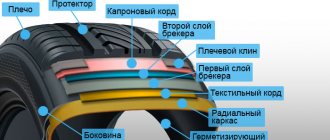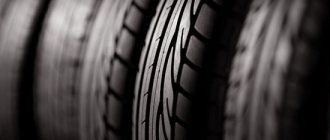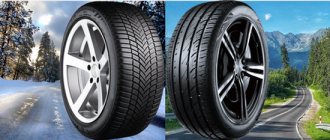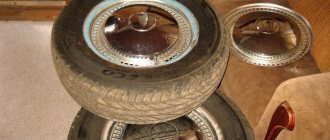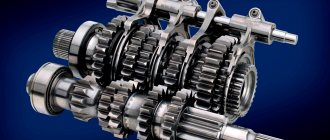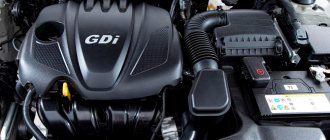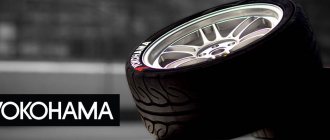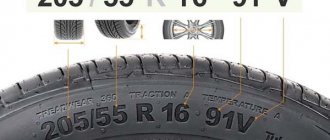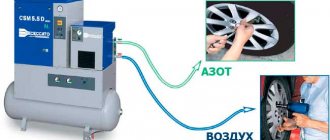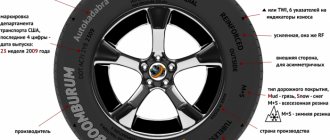A highway can be smooth or rough . In the foothills the trails are littered with stones, in swampy areas the soil is marshy, and in winter there is ice and snowfall. The varying conditions of the road surface require different types of tires . Therefore, there are tires with different tread patterns and internal structure. There are tubed and tubeless options. There are wheels made from a solid cast pipe, without air inside.
Alloy tires are characterized by unregulated rigidity ; they transmit vibration from road unevenness, create excessive noise, and are limited in speed. Newer molded tire designs resemble polyurethane spokes . Cast pipes are used at low speeds, in military equipment, wheelchairs, children's transport, where it is necessary to avoid punctures.
What are tubeless tires
The tubeless tire was developed in 1903 by a representative of Goodyear. But it went into mass production only in 1954. When comparing the features of the two types of tires, it is necessary to study the structure of a tubeless tire. Lastly, as the name implies, there is no chamber, and inside they are covered with a two-centimeter layer of rubber, which is necessary to ensure tightness. The sealing layer is attached from the inside using vulcanization.
In addition, a layer of special rubber effectively seals the junction of the disk and tire. The rim of the disc has a shelf, and the tire hugs it due to the presence of rounded protrusions. As a result, the necessary tightness is ensured. And so that air can flow inside, a valve is installed on the rim of the disk.
When punctured, rubber with a chamber is deflated almost immediately, because air escapes not only through the hole formed, but also, due to a leak in the seal, in the area of the disc rim. And due to the fact that the car continues to move for some time, the punctured tire fails because its other elements are damaged. From a tire that does not have a tube, air comes out only at the puncture site, and this can happen very slowly (it all depends on the size of the puncture), as the nail, screw or other object that caused the damage gets stuck in the hole and becomes a kind of plug .
Note! A tire without a tube is characterized by better tightness, there is no risk of elements rubbing, therefore, if you puncture a wheel, you can drive to a service station and have the tire repaired.
Tires of this type are available in winter, summer, and all-season. However, experts recommend changing them according to the season, since winter tires differ from summer tires not only in the tread pattern, but also in the composition and characteristics of the material, the design of the frame - cord and sidewalls. For example, the tread of winter tires is made of a softer material.
There are radial and diagonal tires. Radial tires are softer, save fuel due to rolling resistance, and improve vehicle handling. But they are more suitable for driving on a good flat road. For driving on bumpy roads, bias-ply tires are recommended as they are more resistant to damage.
What do the two types of tires have in common?
Tube and tubeless tires are pneumatic wheel types . Due to the presence of air inside the tire, the rolling resistance coefficient decreases, driving speed increases, fuel economy increases, and the ride softness improves. Compared to cast tires, pneumatic tires create more comfort while driving and produce less noise.
The speed and maneuverability of tubed and tubeless tires largely depends on the pattern, tread depth, block size and rubber compound material.
The advantage of tubeless tires over tube tires
Tubeless tires are considered more comfortable and technologically advanced due to a number of advantages:
- If you happen to puncture a tire while traveling, the tire will maintain normal pressure. Even on a broken wheel you can drive several tens of kilometers, and if you periodically pump it up, even more.
- A smooth decrease in pressure inside the wheel reduces the risk of loss of control, for example, in an accident, which makes this type of tire safer. The likelihood of a rapid loss of performance is almost zero due to the structural features and strength.
- It is lighter, so it puts less stress on the suspension. At the same time, the inertial movement of the wheel is reduced if the car accelerates or brakes. As a result, the chassis wears less.
- It does not heat up as much as tube tires under fast driving conditions and on long trips. In its predecessor, the tube and tire rub against each other. This not only accelerates wear, but also increases the risk of sudden loss of seal, especially in the summer heat.
- Quick repairs can be done on the go using a paste or spray. This will allow you to get to the nearest service station.
- It is rubber without a tube that lasts 10-12% longer, because the heat from the tire is transferred to the disk and the heat is removed.
- One of the good characteristics that makes tubeless tires better than tube tires is that they produce less noticeable noise when driving.
- Can withstand heavy loads.
- Improves vehicle cross-country ability.
However, tubeless tires also have disadvantages:
- They are installed on special equipment and on a geometrically correct disk. Damage to the rim can lead to depressurization of the tubeless tire.
- Like installation, repairs must be performed using special equipment - it is expensive and time-consuming. Regular tires can be repaired at home.
- If a tire is severely flat, you cannot drive on it for a long time; this will lead to tire failure. After such experiments, it cannot be restored - the sealing layer is destroyed.
- Weak sidewall. But there is a plus to this, because it ensures smooth movement, absorbing bumps and potholes on the road.
- Vulnerable to lateral damage. If on the way to the junction of the tire and the wheel there is an impact, which will lead to deformation of the disk and side flanges, then the wheel can go flat instantly due to a leak.
How to find out which tires are installed - tube or tubeless - will be discussed below.
What is a tubeless tire
The main question that arose for me when I first learned or heard about this type of rubber was “How is the air retained and not released out, that is, what ensures the tightness of the connection between the tire and the disk?” As it turned out, a special layer of special rubber, which is applied during production on the inner ring of the tire, is responsible for the tightness. A tubeless disc differs from a regular disc in that it has a more complex structure and reliable fixation. On the rim of a tubeless tire there are so-called “humps” that firmly hold the tire bead in the right place.
Video about tire pressure! I recommend!
Topical: How to choose mud tires for SUVs? What to look for when choosing?
How to recognize a tubeless tire
The ability to identify certain differences between tubed and tubeless tires is of practical importance. Having purchased a used car, you need to figure out what is on the rims, because tubed and tubeless tires are maintained completely differently, and on the road you need to be prepared for any turn of events.
If you do not take into account the price, which will be much higher for tubeless tires, and focus on the appearance and structure, then in tube tires a tube, which is a pipe-ring, is placed inside the tire. Tubeless tires differ from tube tires in the absence of a tube and in the fact that the outer circle is compacted, and the inner circle is a soft coating.
Tubeless tires fit much tighter on the rim due to the increased bead angle, therefore providing greater tension in the area of the seat flange.
Here's how you can tell if your tires are tubed or tubeless based on their appearance:
- If the inscription “Tubeless” or “TL” is present, it means the tire is tubeless, but if it is “Tube type” or “TT”, it means it is tubeless. However, it happens that the markings have worn off or are missing. The absence of markings without signs of its presence indicates that the tire is too old and there is a tube in it, since it was created at a time when other varieties were not found and there was no need for markings. If the marking has worn off, pay attention to secondary signs.
- The nipple of a tubeless tire is small, tightly fitting, with a small flange at the base. The tube tire is equipped with a longer nipple, smooth and movable. If you bleed a little air from the tire, you will not be able to press the valve of tubeless tires inward; on a tire with a tube, it can be completely pressed inward.
- If the previous determination methods are not suitable, then the last one remains - the most labor-intensive - beading.
Disadvantages of a tubeless tire
- Tubeless also has disadvantages. For example, their installation requires special attention, special equipment and certain skills. Damage to the beads and flanges may cause the tubeless tire to depressurize or require repair.
- Major repairs of a tubeless tire are carried out using special equipment by specialists and this “pleasure” costs a lot of money. Unlike tube tires, which can be repaired yourself, repairing tubeless tires requires greater skill and appropriate tools.
- Driving for a long time on a flat tubeless tire (please do not confuse it with a punctured tire, but pumped up to the optimal pressure) is fraught with destruction of the sealing layer and the tire as a whole.
- Tubeless tires are often blamed for a problem called weak sidewall. However, in my subjective opinion, the accusations are groundless. First of all, it should be noted that ideal tires do not exist and, no matter what manufacturers lie, ideal tires are still only a myth. The manufacturer's goal is to achieve not only strength from the tire, but also to provide comfort to passengers while driving. The aforementioned sidewall is responsible for this factor; its softness provides a feeling of smooth movement. A hard sidewall will not do anything good other than racing; even a smooth road will seem bumpy with a “wooden” sidewall.
- Another significant drawback of tubeless tires is the vulnerability in the area where the rim and tire bead meet. If, for example, you “dent” the disk even a little (by getting into a hole, or catching a curb), you will be in trouble, the wheel will deflate instantly, almost like a tube tire with a puncture. The fact is that a violation of the tightness of the connection, which occurs due to damage to the disk, will lead to the fact that the pressure in the tires will begin to drop rapidly, in other words, the tire will go flat.
Current: Two sets of wheels or 2 times a year for tire fitting?
Is it worth changing cameras to tubeless?
Previously, only professional racers could afford tubeless tires, but now tubeless is available to almost anyone. We'll talk about them today. Let's look at the pros and cons and help you answer the question - is it worth it?
Tubeless has been around for a long time in the automotive industry, so it's no surprise that it's gaining popularity in the cycling world as well.
In order to get rid of tubes you will need a special tire, a special rim or a kit for converting regular rims and a special nipple for tubeless. To keep the tire and rim sealed, a special sealant is used; this is one of the key elements of the entire structure.
The article addresses the following issues:
Tube tires
The tires of some wheeled vehicles consist of tires and rubber tubes with a valve through which air is pumped. The valve is closed with a screw cap or a key in the form of a cap. The chamber is a rubber tube closed with a ring . Elastic rubber holds compressed air. The chamber material is wear-resistant, durable, designed to withstand temperature changes and constant deformations in different directions.
The rubber pipe is adjusted exactly to the inner size of the tire into which it is inserted. The air-filled chamber should not form folds or gaps. The internal volume of the wheel should be filled as much as possible with the inflated chamber. Then the tire will have better running characteristics and a short braking distance.
For cars, tube tires are almost never used today and replacement tubes are not produced.
Tube wheels are installed on:
- Motorcycles.
- Scooter.
- ATVs.
- Bicycles.
The rubber ring cannot be installed in a tubeless design, which leads to increased pressure, heating during movement and explosion of the wheel.
Pros:
- Low prices.
- In case of side wheel cuts, it is enough to change the inner tube.
- Easy to select wheels.
Minuses:
- The smallest puncture leads to a release of pressure. You have to stop to change a tire on the road. The need to have a spare tire.
- This type of tire is heavier.
- Repairing a small puncture is more difficult.
- Currently, spare tubes and tube types of tires are practically not produced.
Pros and cons of tubeless
pros
You will definitely have fewer punctures . The tire is severely deformed when you hit a rock or curb, and if the impact is strong enough, the tire is dented so that you get a “snake bite.” The camera seems to be “bitten” by the tire and a couple of extra holes are formed in it.
In addition, through new extra holes in the tire, which appeared from a thorn or nail, under the influence of internal pressure in the tire, sealant begins to come out, which seals the hole. So you may not even notice that you've broken through, and it saves time on installing patches.
You will have more traction . After installing a tubeless tube, you can ride at lower tire pressure without fear of snake bites, while the tire's contact area with the ground increases.
Plus, lower pressure allows the tire to absorb surface imperfections much better rather than bounce off them, resulting in a smoother ride.
You'll save some weight . We all know how heavy thick-walled cameras can be, and getting rid of them can save some weight. Of course, sealant will replace the camera, but much less of it is needed, so sometimes you can save up to 200 grams on the wheel.
The big plus is that you reduce the unsprung weight of the bike, and you will also spend less effort on acceleration. Therefore, the suspension will work a little better, and your legs will get a little less tired.
Tube tires: features, advantages and disadvantages
Tube tires might have been around for a very long time if they had not been supplanted by their more advanced tubeless successors. The latter simply supplanted their predecessors and were warmly received by the entire global automotive community. By the way, some “old believers” still use tube tires, they have their own reasons for this, for example, the tube can be replaced, repaired, and done with your own hands - cheap and cheerful! In principle, they are right in some ways, and if you do not take into account all the dubious “advantages” of tubeless, the only difference between tubeless and tubeless is that the latter, in the event of a breakdown, will allow you to get home or to the nearest service station, without problems or danger for life. The chamber wheel, as mentioned above, will deflate almost instantly.
I recommend: Critical tire wear: what is it, why is it dangerous and how to prevent it?
In addition to other disadvantages, tube tires are also dangerous because there is a high probability of the tube being punctured from the inside by a worn or broken cord. As a result, you will end up with a punctured tire and a stationary car. Even if a tubeless tire is punctured, the air does not have the ability to quickly leave the boundaries of the tire due to the reasons described above, and also due to the fact that in the event of a puncture by a sharp object (screw, wire, wooden thorn, etc.), the object itself gets stuck in tire, it becomes a kind of traffic jam. By plugging the hole he made, he does not allow air to escape through the puncture.
On the other hand, you can always use a spare tire and drive home or to a service center with it; it is not necessary to start disassembling and repairing a tube tire on the spot. Although from time immemorial, sealing the inner tube and disassembling the wheel was considered a “trifle” for the stern Russian peasant. It’s not surprising that tubeless was invented not by “we”, but by some “foreign wimp” who could not or did not want to tinker with a jack, glue and other tools.
